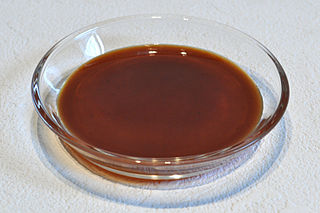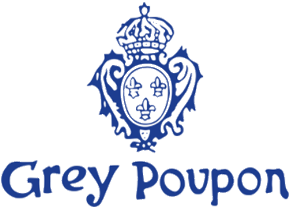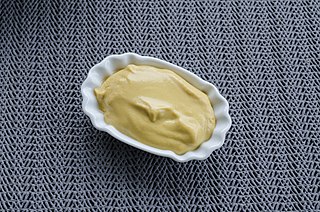
Tabasco is an American brand of hot sauce made from tabasco peppers, vinegar and salt. It is produced by McIlhenny Company of Avery Island in south Louisiana, having been created over 150 years ago by Edmund McIlhenny. Although the tabasco peppers used in the sauce were initially grown only on Avery Island, they are now primarily cultivated in Central America, South America and Africa. The Tabasco sauce brand also has multiple varieties including the original red sauce, habanero, chipotle, sriracha and Trinidad Moruga scorpion. Tabasco products are sold in more than 195 countries and territories, and packaged in 36 languages and dialects.

Worcestershire sauce or Worcester sauce is a fermented liquid condiment invented by the pharmacists John Wheeley Lea and William Henry Perrins in the city of Worcester in Worcestershire, England, during the first half of the 19th century. The inventors went on to form the company Lea & Perrins.

Ketchup or catsup is a table condiment with a sweet and sour flavor. The unmodified term ("ketchup") now typically refers to tomato ketchup, although early recipes for various different varieties of ketchup contained mushrooms, oysters, mussels, egg whites, grapes or walnuts, among other ingredients.

HP Sauce is a brown sauce, originally British, the main ingredients of which are tomatoes and tamarind extract. It was named after London's Houses of Parliament. After making its first appearance on British dinner tables in the late 19th century, HP Sauce went on to become an icon of British culture. It was the best-selling brand of brown sauce in the UK in 2005, with 73.8% of the retail market. The sauce was originally produced in the United Kingdom, but is now made by Heinz in the Netherlands.

Chili con carne, meaning "chili with meat", is a spicy stew containing chili peppers, meat, tomatoes, and often pinto beans or kidney beans. Other seasonings may include garlic, onions, and cumin. The dish originated in northern Mexico.

Zatarain's is an American food and spice company based in New Orleans, Louisiana, in the United States that makes a large family of products with seasonings and spices that are part of the cultural cuisine and heritage of Louisiana and New Orleans' Cajun and Creole traditions that includes root beer extract, seasonings, boxed and frozen foods.

Hot sauce is a type of condiment, seasoning, or salsa made from chili peppers and other ingredients. Many commercial varieties of mass-produced hot sauce exist.

Grey Poupon is a brand of Dijon mustard which originated in Dijon, France.

The generic term for condiments in the Filipino cuisine is sawsawan. Unlike sauces in other Southeast Asian regions, most sawsawan are not prepared beforehand, but are assembled on the table according to the preferences of the diner.

Wish-Bone is an American brand of salad dressing, marinades, dips and pasta salad. The original salad dressing was based on a recipe served at the Wishbone restaurant in Kansas City, Missouri, founded by ex-soldier Phillip Sollomi in 1945 along with Lena Sollomi, Phillip's mother. The Italian dressing served at the Wishbone was based on a recipe from Lena Sollomi's Sicilian family which was a blend of oil, vinegar, herbs and spices. Demand for the salad dressing proved so high that Phillip started a separate operation to produce it for sale, making it by the barrel. The brand was acquired by Lipton, part of the Unilever portfolio, in 1958, and was manufactured in the Kansas City area. In 2013, Pinnacle Foods acquired Wish-Bone from Unilever. In turn, ConAgra acquired Pinnacle Foods on October 26, 2018.
Keen's is a brand of seasoning products produced by McCormick Foods Australia, the Australian branch of the American food company McCormick & Company, and by McCormick Canada in Canada. The Keen's brand has a long history and remains a common item in kitchens throughout Australia. The brand is particularly well known for its distinctive yellow and orange tins.
Rosa Food Products was started in Philadelphia in the year 1900 by Giacomo Foti. He named his store and products Rosa after his wife. At first it was only a small store on the corner of 13th and Federal Streets in Philadelphia. Over time, hundreds of stores bearing the Rosa name were created. A warehouse was needed to supply all the stores with hundreds of products bearing the Rosa name. Giacomo Foti and his son, Leonardo, were packaging cooking oils for their Rosa brand, Rita brand and also for private label customers. As the large supermarkets came into existence, the smaller stores began to close. It was easier to supply the supermarkets with products than their own stores. Rosa Food Products then became a wholesale food distributor.

Mustard is a condiment made from the seeds of a mustard plant.

International Home Foods (IHF) was an American manufacturer, distributor and marketer of food products, based in Parsippany, New Jersey. It was acquired in 2000 by ConAgra Foods and merged into ConAgra's Grocery Products division. IHF's best known brands were Chef Boyardee pasta products, Bumble Bee Seafood, PAM cooking spray, and Gulden's mustard.
Bertman Original Ballpark Mustard is a brown mustard made by Bertman Foods Company, a Cleveland, Ohio, food manufacturer and distributor which has produced several varieties of mustards since 1925, well known regionally because they are served at sports stadiums around Cleveland.
Joseph Bertman (1902–1988) born in Lublin, Poland, founded Joseph Bertman, Inc. as a wholesale grocery business in the 1920s in Cleveland, Ohio. He created the formulation for a mustard that became iconic in Cleveland, Ohio which spawned two brands, Bertman Original Ball Park Mustard and Stadium Mustard.












